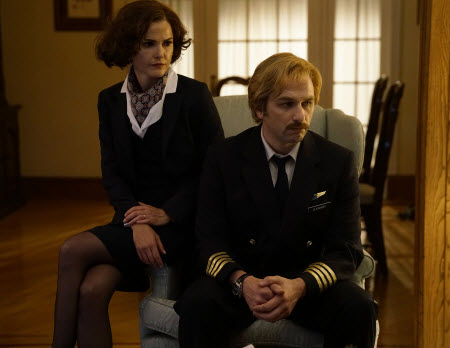Writing the Final Chapter

BROOKLYN, N.Y. — On a side street lined with industrial buildings, Elizabeth and Philip Jennings, the Soviet spies who pass as local travel agents, arrive for a meeting with their handler. This isn’t the latest scene from an FBI investigation into Russian hacking of U.S. emails.
It’s the filming of season five of FX’s The Americans at the Eastern Effects studio. While nearly every scene in this series is ominous and foreboding, the atmosphere on set remains light.
As the crew sets up the shot, the conversations are about Nutter Butters and other snacks, with someone riffing about “cheeses of Nazareth.” Suddenly, a booming voice, jolly in tone, issues a decree: “Once again, everyone, it’s time to entertain the world.”
And into this jovial atmosphere the stars emerge and take their marks. As The Americans heads into season five, the show is at a turning point, a moment that turns the normal arc of a popular series on its head.
Despite wildy rapturous critical applause, the ratings and audience demographics never matched up and indeed slipped to new lows last year.
AWARDS SHOWS TAKE NOTICE
At the same time, though, the show grabbed its first-ever Golden Globe nominations (for stars Matthew Rhys, who plays Philip, and Keri Russell, who plays Elizabeth). And last year, it finally got some generous love from the Emmys: outside of the theme song, only Margo Martindale, who plays Claudia, Philip and Elizabeth’s KGB handler, was nominated for the show’s first two seasons; the show got its first writing nod for season three (with Martindale for best supporting actress). But season four marked the breakthrough, with Martindale (who won again) joined by nominations for Rhys, Russell, the writing and for Outstanding Drama Series.
All that attention came not long after showrunners Joe Weisberg and Joel Fields, along with network executives, decided to end the series after six seasons. This means season five, which begins March 7, is the start of the show’s home stretch.
The new season also marks the show’s biggest tone change since season two, when it shifted from an episodic spygenre show to a serialized drama about a family that happens to be spies. And the changes have nothing to do with reflecting the current state of U.S.-Russian affairs. “We talk about that during lunch, but the show is in a bubble in the early 1980s,” Weisberg said.
Fields acknowledges that the audiences may now view the show differently, but said the issues of identity, trust, how we view the “other” and the “enemy” have always been its essential themes. The show has also always been a story about immigrants trying to fit in while dealing with mixed emotions about the land they left behind, Weisberg said.
“We realized that the spy stories took up three-fourths of every episode and there was not space to tell the story of this marriage and this family,” Fields said of that first season. “That became the focus and it radically shifted how we wrote the show.”
Added executive producer Stephen Schiff: “We pushed the show into new territory because now we could. We could make it more personal and less genre-specific.”
Schiff was one of four new writers brought in for that second season as part of the change.
The shift “allowed us to think about the show novelistically and to chart everything long-term,” Weisberg added. For instance, if an episode was running too long, the creative team could push its last 10 or 15 minutes into the next episode without sacrificing character development.
The writers took more risks. For instance, the opening scene of season five occurs in a high-school lunchroom with students the audience has never seen before; the ’80’s new wave soundtrack gives the scene a feel closer to an immigrant’s take on The Breakfast Club rather than The Americans.
“That whole opening was intentional,” Fields said. “We said, ‘Let’s have some fun and really change things up.’ ” (Ultimately, he noted, “try as I might, it still is The Americans and I’m never going to do the musical episode I’ve always wanted to do.”)
Weisberg said the large change for season five is that several major characters from the first four seasons — Nina Krilova, Martha Hanson and Frank Gaad — are all gone, giving the writers more room to focus on the Jennings family.
“The tone of the season is different, but it’s not because we’re closer to the end,” Schiff said. “It’s because Philip and Elizabeth are evolving and we see that evolution very clearly in season five.”
Cleaning out to focus on the core characters was an organic decision, according to the writers, who said FX has always supported them without much concern for the ratings. The show has never been even close to a breakout hit and, in fact, it lost 12% of its viewers and 17% of its viewers 18-49 in season four.
Its 910,000 viewers in the 18-49 demo was the secondlowest number of any Emmynominated series last year and among dramas, it badly trailed its competitors not just in that demographic but in overall viewers, drawing 2.1 million. It was only close to USA Network’s Mr. Robot (2.74 million), and far from AMC’s Better Call Saul (4.8 million), Showtime’s Homeland (6.1 million), HBO’s Game of Thrones (10.6 million) and PBS’s Downton Abbey (11.5 million).
Building viewers has been more difficult because the older episodes required for catching up are on Amazon Prime (and iTunes), but not Netflix, which is in far more households.
FX executives shrug, unconcerned. For starters, the show’s older audience is educated and wealthy and thus desirable to advertisers. But an equally significant statistic might be that The Americans garnered a 99% rating on Rotten Tomatoes last year and a 95% on Metacritic, making it the most critically acclaimed series in all TV-dom.
PRESTIGE ADDS VALUE
“The show’s value goes beyond its ratings,” said Eric Schrier, president of original programming at FX Networks and FX Productions (along with Nick Grad). “It’s important for our profile, for the brand.”
Schrier said the Emmy nods may not provide a quantifiable ratings boost but do add brand luster. The show’s quality and reputation also have “long-term value” because FX is a co-producer and part owner of the show [with Fox 21], he said. (Fields welcomes FX executives’ suggestions: “They’re diligent and brilliant, they’re like dramaturges and they see the show with fresh eyes,” he said, adding that he and Weisberg have already incorporated a few notes into reshoots for this season.)
The show’s shelf life will come into focus sooner rather than later with its finale coming in 2018. Weisberg says he and Fields took a long walk in Brooklyn’s Prospect Park during season two and figured out how they wanted to end. Schrier said they decided on the “when” during season four; he said it was a conversation between the showrunners and the executives, adding FX would have been open to five, six or seven seasons, depending on what the creators felt they needed.
“We thought it would help them map it out if they knew and that would help the ending,” Schrier said, pointing out that FX prefers to have shows go out on top creatively. The network made creative decisions to end The Shield, Sons of Anarchy and Justified, rather than milk them for every last dollar.
“Series have a natural beginning, middle and end,” he said.
This story was updated on March 7 to correct a mistake in the photo caption.
Multichannel Newsletter
The smarter way to stay on top of the multichannel video marketplace. Sign up below.
Stuart Miller has been writing about television for 30 years since he first joined Variety as a staff writer. He has written about television for The New York Times, The Washington Post, the Los Angeles Times, The Guardian, The Boston Globe, Newsweek, Vulture and numerous other publications.

